Warm-up and maintenance tips
for ESL kids teachers
Warm-up and maintenance tips to use in your ESL kids classes
Tips and ideas for starting your kids English lessons!
Younger students (ages 3-9) warm-up activities:
- Supplies: cushions (one for each student), name tags, glove puppet in a cloth bag, any supplies from previous lessons to use for reviewing.
- Songs: ‘The hello song‘ or a review song from last class.
These activities can be done in the following order at the start of your lesson:

1. Greetings
Greet the students by name as they enter the classroom and gesture for them to sit down. It’s a good idea to have a cushion for each student as this makes sitting arrangements easy to organize. Try and arrange the cushions beforehand spaced out in a fan-shape around you.

2. Name tags
Before class, prepare some name tags (stickers or pin-on tags) with each student’s name written on in lowercase letters. Sit down with your students and lay out the name tags in front of you. Pick up each tag and call out the name. Try and encourage each student to put their hand up and say, “Yes”. Hand over the tags and help to pin / stick on. For older students, have them write their names on their name tags.

3. Glove puppet greetings
Use a glove puppet (such as a Sesame Street puppet) to greet the students. Keep him in a cloth bag. Bring out the bag, open it enough to see in and shout into the bag the puppet’s name (e.g. “Cookie Monster!”). Then move your ear to the opening to listen – nothing. Go to each student and encourage them to shout the puppet’s name into the bag – each time nothing happens.
Finally, get all the students together to shout the puppet’s name at the same time – this time the puppet wakes up and jumps out of the bag! The puppet then chats to each student: “Hello”, “What’s your name?”, “Goodbye / See you” before going back into the bag and back to sleep.
As lessons progress, the puppet can ask new questions based on what your students have learned.

4. Sing “The hello song” or a review song
Sit in a circle and sing along to the song. Encourage students to clap along or pat their laps in time with the music. ‘The hello song‘ is a good song to start with.
5. Homework check
Check each student’s homework that you set in the last lesson. Ask each student some questions about their homework (e.g. “what color is it?”), give lots of praise, and then put some kind of mark on the homework sheet (e.g. a sticker or a stamp – I draw a smiley face). Finally, tell your students to put their homework back into their bags.

6. Do “Exercise routine” activity
Say the following and have the students follow your lead:
- Stand up (teacher stands and so does everyone else)
- Hands up / hands down (x 3-5)
- Jump (x3-5)
- Run! / Stop! (x3-5)
- Turn around! / Stop! (x3-5)
- finally “Sit down”.
Throughout the course you can introduce other commands, such as “hop”, “star jump”, “wiggle”, “crouch” and so on.

7. Review past lesson vocab / structures / games / songs / etc.
Reviewing past lessons is very important – students need constant practice of new vocab, structures, songs, games and so on. Always review your last lesson as well as some parts from other previous lessons. You can spend 5-10 minutes reviewing – it’s fine to recycle games and activities from your past lessons to review as kids enjoy playing familiar games (although be careful not to play a game to death!).
Note: You can also include review activities in the main body of your lesson. Little kids have short attention spans so it’s good to be able to pull out lots of activities during different stages of the lesson.
Other ideas to include in your warm up:

What’s in the bag?
This is a great activity to do at the beginning of your lessons. Fill a large cloth bag with items from your previous lessons (e.g. plastic fruit, animals, etc.). You can also throw in a few other objects (e.g. an eraser, a plastic bottle, a plastic cup – anything lying around (and safe!)).
Show the bag to your students and shake it to rattle the objects inside. Pull out different objects, teach/elicit their names, have students hold and pass the objects around. You can even have students pull objects out of the bag. Take out 1 or 2 objects per student.
Finally, place or throw the objects around the classroom and have each student retrieve each object as you call out its name and put it back in the bag.
Older students (ages 9+) warm-up activities:
These activities can be done in the following order at the start of your lesson:
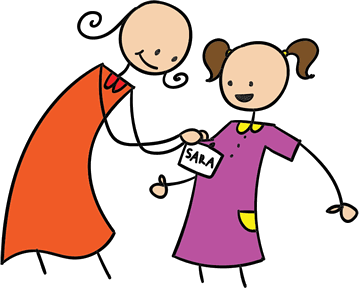
1. Greetings and name tags
Greet the students as they enter the classroom and gesture for them to sit down. Before class prepare some blank name tags (stickers or pin-on tags). Give these out and have everyone write their names and put their tags on. If you use pin-on tags, you can keep and give out every class.
For students who use a non-roman alphabet (e.g. Japanese), they should write their name in English letters – if they have never done this before you may have to help (possibly prepare their names on paper to copy).
2. Do a fun review activity
Let’s kick off the lesson with a fun activity that reviews vocabulary, structures, grammar or any other aspect from previous lessons. This should be a fun and fast-pasted section of the lesson reviewing a range of topics from your course. Some examples include,
Ball pass questions
In this example, students start by reviewing classroom objects and numbers. However, this activity can be used for almost any type of review.
Get everybody standing in a circle.
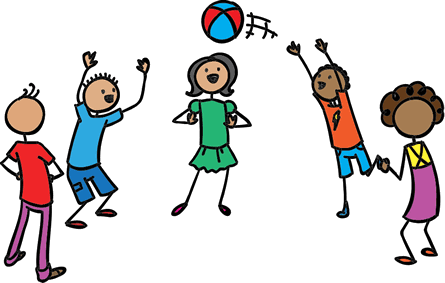
Round 1:
Take a ball and hold it and ask, “How many tables are there?”. Then throw the ball to a student who should give the answer, then ask another “How many” question and throw to the next student. Continue around all the students.
Round 2:
This time we’ll review food vocabulary. Say, “Say food words”. Say a word (e.g. cheese) and throw to the next student. Students keep throwing and saying food words within a short time limit (e.g. 3 seconds). Failure to say a word in that time means the student sits down. Keep playing until only one student is standing.
Continue with other rounds reviewing different topics.
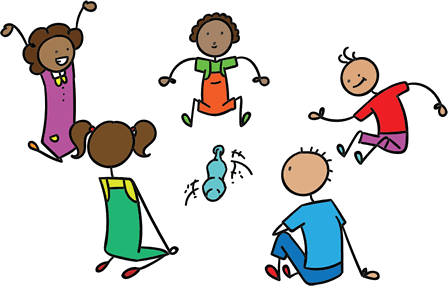
Spin the bottle
Sit everyone in a circle with a bottle in the middle. Teacher spins the bottle. When it stops spinning the student it is pointing to has to answer a question. If the answer is correct, then that student can spin the bottle. Either the teacher or the student spinning the bottle can ask the questions. Again, you can cover pretty much every topic with this activity.
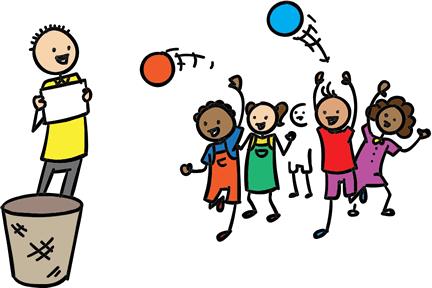
Vocabulary basketball
You will need a basket (a trash can) and 2 balls (or 2 pieces of A4 paper scrunched up into balls).
Form 2 teams and line them up so that two players from each team are facing the front with the basket in front of them. Let both players throw their ball – if they get their ball into the basket they can try and win a point by giving the correct answer to a question the teacher asks – this can be based on any review topic. Then they go to the back of the line. At the end, the team with the most points is the winner!
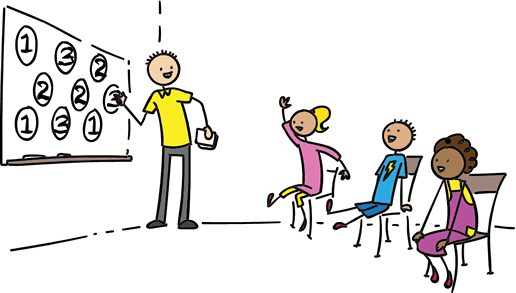
Quiz game show
This is a fun quiz game, like a simple version of a TV game show. Draw some circles on the board and randomly write numbers 1, 2 or 3 in each circle. These will be points.
Put students into teams. Then ask the first team to choose a number – “1” is an easy question (e.g. “Do you like bananas?”) and “3” is a difficult question (e.g. point at a clock and ask, “What time is it?”). “2” will be in between in terms of difficulty. When the question has been answered correctly, erase that number circle. Play until all the number circles are gone – the team with the most points is the winner!

Review dice quiz
This is another fun team quiz. Put students into teams of 3 or 4, each team sitting around a table. Give each team a “buzzer” – basically
something that makes a noise (a bell, a toy buzzer, a squeaky toy, an instrument, etc.).
The teacher asks a review question – the first student to “buzz” can answer. This is where the dice comes in (you can use one die or for larger number practice, 2 dice). If the student answers correctly, s/he rolls the dice – the number it lands on is the points they win for their team. However, if they get the question wrong (or make a mistake) they roll the dice to lose points!

3. Homework check
Check each students’ homework worksheet and ask some questions based on their homework sheet. Give lots of praise, and then put some kind of mark on the homework sheet (e.g. a sticker, a stamp or draw a smiley face). Finally, tell your students to put their homework back into their bags.

4. Talk about the weather using the “Weather board”
Drop this section into your lessons after you have done a lesson on weather vocabulary. You’ll need to create a weather board – cardboard or a canvas with blue felt covered over it – we have created a video on how to do this. Write at the top of the board in large letters, “How’s the weather today?”. Below this write “Today it’s”.
Cut out weather pictures (such as our weather flashcards) and stick some Velcro on the back of each picture. Arrange the weather pictures around the edge of the board and then put the board on the wall of your classroom.
Invite some students to come up and put weather pictures for today’s weather on the board. As they do this ask, “How’s the weather today?” and elicit the “It’s [word for the picture]”.
You can also add other Velcro-backed vocabulary such as the days of the week, months of the year and seasons.

5. Do a review activity (or activities) from the last lesson
This should be a more in-depth review from new topics in your last class. Take an activity or a few activities that you did in the last lesson and do them again. This could be a game, a quiz, an exercise, a story, a song … basically any element that you practiced in your last class that will help to review the new language your students studied.
You are now ready to proceed with the new learning section of your lesson!

